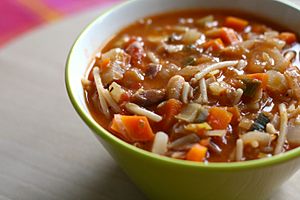Minestrone facts for kids

Homemade minestrone
|
|
| Type | Soup |
|---|---|
| Course | Lunch or dinner |
| Serving temperature | Hot |
| Main ingredients | Vegetables (beans, onions, celery, carrots, tomatoes), stock or water, often pasta or rice |
Minestrone is a hearty and thick soup that comes from Italy. It's usually packed with lots of different vegetables. Sometimes, people also add pasta or rice to make it even more filling.
There isn't one single recipe for minestrone. That's because it's often made with whatever vegetables are fresh and available. It can be made without meat (vegetarian), or it can include meat or a broth made from animal bones. A famous food writer, Angelo Pellegrini, said that the best minestrone starts with a broth made from borlotti beans.
The Story of Minestrone
Minestrone soup has a very long history! It started even before the great Roman Kingdom was formed in Italy. Back then, people mostly ate vegetables because they had to. Their meals included things like onions, lentils, cabbage, garlic, broad beans, mushrooms, carrots, and turnips.
In those ancient times, a common meal was pulte. This was a simple but filling porridge made from spelt flour cooked in salty water. People would add any vegetables they had to it.
Around 200 B.C., Rome grew powerful and connected Italy with roads and trade. This brought many new foods to the capital. People's diets started to change, and they began to eat more meat. Meat broths were also used for soups.
Bread became popular in Rome thanks to the Greeks. Because of this, spelt flour was no longer a main ingredient in soups. Pulte became a meal mostly for poorer people.
The ancient Romans believed that a simple diet, full of vegetables and grains, was good for health. So, thick vegetable soups remained a very important part of their meals.
A Roman cookbook from about 30 AD, called De Re Coquinaria, describes a soup called polus. It was made with farro, chickpeas, and fava beans. Onions, garlic, and greens were also added.
As food and cooking changed in Italy over time, so did minestrone. Today, minestrone is known as a dish from "cucina povera." This Italian phrase means "poor kitchen" or "peasant cooking." It refers to simple, rustic dishes that come from the countryside, not fancy meals made for rich people.
What's in a Name?
The word minestrone means a thick vegetable soup. It first appeared in English around 1871. It comes from the Italian word minestra, which means "soup." More literally, minestra means "that which is served." The Italian word minestrare means "to serve."
Because there's no single recipe, minestrone can be very different across Italy. It depends on local traditions, ingredients, and the season. Some minestrone soups are very thick with soft, well-cooked vegetables. Others are more like a broth with larger, lightly cooked vegetables. Some even include meat.
In modern Italian, there are different words for "soup." Zuppa is used for lighter soups like tomato soup. Minestra is for more filling soups, like vegetable soups, and even some pasta dishes. Minestrone means a very large or substantial soup or stew. This word is now mostly used for this specific famous dish.
Different Kinds of Minestrone
There are many regional versions of minestrone across Italy and beyond!
- Minestrone alla Genovese is a type from Liguria, a region in Italy. It uses more herbs, especially pesto, which gives it a special flavor.
- Minestra is a similar soup from Malta. It often has kunserva (a thick tomato paste), potatoes, kohlrabi, cauliflower, and sometimes spaghetti.
- Imbakbaka or Mbakbaka is a stew from Libya. It includes pasta, chickpeas, a spice mix called Bzar, and meat. This dish came about because of Italian influence in Libya.
See also
 In Spanish: Minestrone para niños
In Spanish: Minestrone para niños


